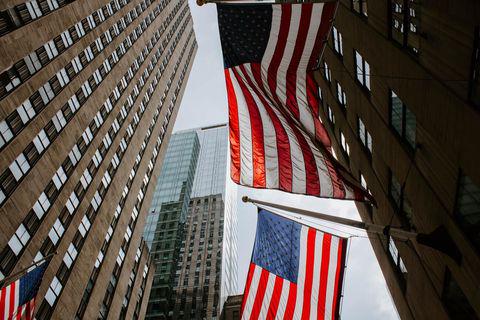
The S&P 500 had a good week due to the impressive start of Q1 earnings and favorable inflation data. In March, the consumer price index rose 5%, lower than the previous month's 6%, and met economists' expectations.

Don’t waste your time – keep track of how NFP affects the US dollar!
Data Collection Notice
We maintain a record of your data to run this website. By clicking the button, you agree to our Privacy Policy.

Beginner Forex Book
Your ultimate guide through the world of trading.
Check Your Inbox!
In our email, you will find the Forex 101 book. Just tap the button to get it!
Risk warning: ᏟᖴᎠs are complex instruments and come with a high risk of losing money rapidly due to leverage.
71.43% of retail investor accounts lose money when trading ᏟᖴᎠs with this provider.
You should consider whether you understand how ᏟᖴᎠs work and whether you can afford to take the high risk of losing your money.
Information is not investment advice
Two years have passed since the first case of coronavirus infection. More than 275 million people were infected, and five million didn't make it. New strains keep on emerging, and vaccines are not always as effective as we want them to be. Moreover, companies try to weaken the virus by implementing other drugs, such as pills. In this article, we went through the main ways of fighting with Covid-19, touched on paces of vaccination across the globe, and made a forecast on the chance of full recovery from the plague of 21 century.
Let's be straightforward. Most of the world haven’t taken Covid serious enough. Dozens of countries said it was just another flu-like virus that would be taken down quickly. Well, they turned out to be wrong. The consequences of this irresponsibility are several waves of virus contamination, unbelievable economic losses, and disruptions of supply chains across the globe.
As for us, the most important example is the US, which reacted too slowly. Also, the country acted differently across the states, which added to the number of cases and overall social and economic damage. The US lost more than 800K people and is losing more now. Because of enormous money printing, inflation reached almost 7% and still increases. As for now, the US has more than 61% of the population vaccinated. Herd immunity needs 80%+ for the people to be immune to the virus. However, the victory for people is close. The same cannot be said about the economy. The national debt increases so fast that the US needs to raise the threshold every couple of months to prevent the country from the default.
Nevertheless, Coronavirus is slowing down its pace in the US and globally. Look at the figures.
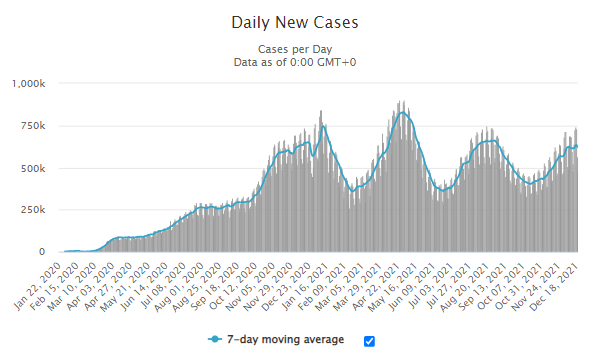
Even though the fourth wave of infection is almost as strong as the third one, it is mostly because of the Omicron strain that is way more contagious but way less deadly. It is confirmed by death cases statistics.
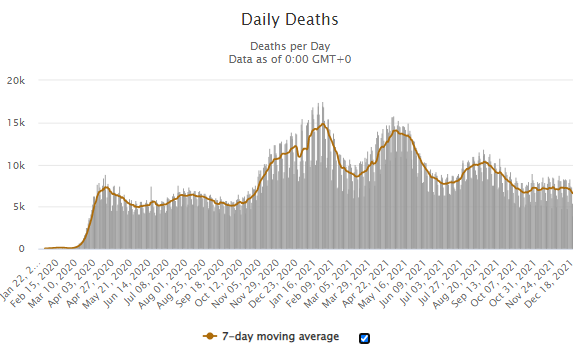
Unlike daily cases, the daily deaths chart doesn't have a fourth wave, and the number keeps decreasing, slow and steady. If the trend stays unchanged, the end of Covid-19 is near.
Currently, several companies fight against the virus, and you know all of them. Let's analyze what we have got to beat Covid.
Moderna has one vaccine (mRNA-1273) with two different use cases. First, you need to receive two shots, 28 days apart from each other. Some people (with certain health issues) should get an additional primary shot (third dose) at least 28 days after their second shot. Also, people ages 18 years and older who received a Moderna primary series should get a booster shot at least six months after completing their primary series.
mRNA-1273 has 95% efficacy against most Covid-19 variants, but as Omicron spreads, we will focus on the latest strain as it's considered the most catching. The company's research shows that the third dose of Moderna's Covid-19 vaccine increased antibody levels against the omicron variant (a 32-fold increase compared with the two-shot vaccination). Moreover, Moderna is testing a new vaccine version to deal with Omicron more efficiently (mRNA-1273.529). The company expect to start clinical trials in early 2022.

A couple of words about Moderna's biggest rivals, Pfizer and BioNTech. They offer two shots, 21 days apart from each other. Also, everyone ages 16 years and older can get a booster shot at least six months after completing their Pfizer-BioNTech primary series. What's curious is that adults can get any Covid-19 vaccines authorized in the US for their booster shot, not just Prizer's. Laboratory studies showed a 25-fold increase compared with two doses against the Omicron variant. Moderna showed better results, although any protection is better than no protection at all.
But Pfizer has an ace in the hole, antiviral pills. Pfizer said its antiviral Covid-19 pill showed near 90% efficacy in preventing hospitalizations and deaths in high-risk patients, and recent lab data suggests the drug retains its effectiveness against the fast-spreading Omicron variant of the Coronavirus.

Merck, another big pharma, also has a pill in the pipeline. However, Merck's pill reduces the risk of severe illness, hospitalization, and death by 30%. The result is far from perfect, that's no doubt. Unfortunately, the release is possible after Christmas, which is later than expected for Merck. But it's better late than never!
If authorized by the Food and Drug Administration, these at-home treatments could be prescribed by doctors and picked up at local pharmacies to reduce the risk of becoming severely ill. Of course, such pills (and new versions of vaccines) are incredibly bullish for the price of the companies. But how long does it take for the world to develop herd immunity? And, what's more important, will the Covid end in 2022?
Let's be straightforward once again and look at paces of vaccination across the globe. First, we need to get at least 80% of Earth's population to have antibodies against Covid. Also, everything gets more challenging with new strains emerging every six months, but we already know what to do with them.
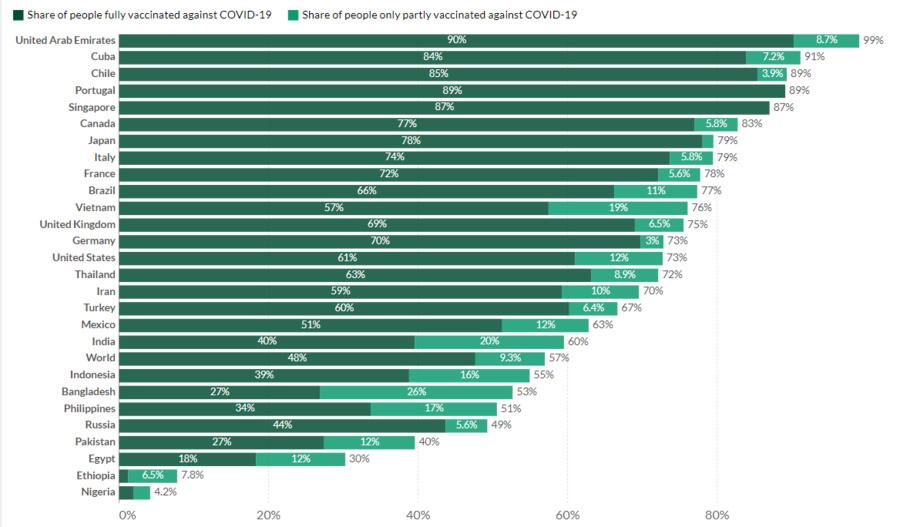
57% of the world population has received at least one dose of a Covid-19 vaccine. 8.78 billion doses have been administered globally, and 36.07 million are now administered each day. In several weeks, that 57% will receive a second dose and become more or less immune to Covid. As for now, 3.63 billion people are fully vaccinated, which is almost 47% of the world population.

The worst vaccination rate is across Africa. For other continents, herd immunity is quite close. Therefore, we can say (with caution, though) that the worst days of the Covid era have passed. The virus will probably become more like seasonal flu, which is still a dangerous infection but more controllable and less deadly. However, don't forget that even flu surprises us from time to time. For example, "swine flu" in 2009 had 491 million confirmed cases and more than 284 000 deaths.
Consider what we have said above, and you'll get the idea: vaccines will soon be less necessary if the companies don't create a pill to fight against Covid. For Moderna, it is crucial, as the company has few products on the market, and its revenue depends on mRNA-1273. Fewer revenues mean a return to mean cost for the stocks or sliding lower. So in the long term, Moderna is likely to fall.
Resistance: 380.0; 455.0; 515.0
Support: 265.0; 230.0; 190.0
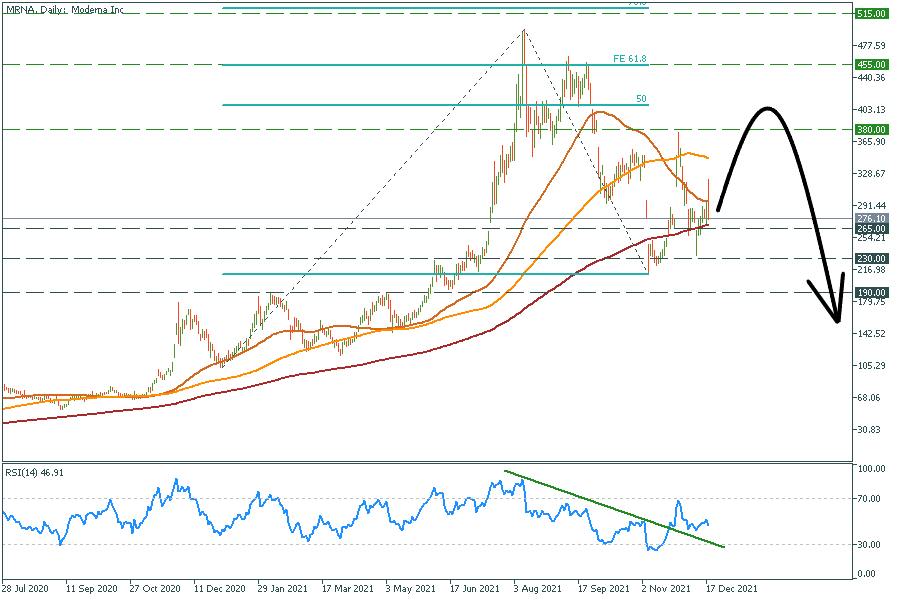
For Prizer, the figures are way more positive. The company has highly efficient pills that will come to market at the start of the year. In addition, a giant pipeline of other products will help maintain high revenues. From the technical side, the stock broke through massive nine-year consolidation.
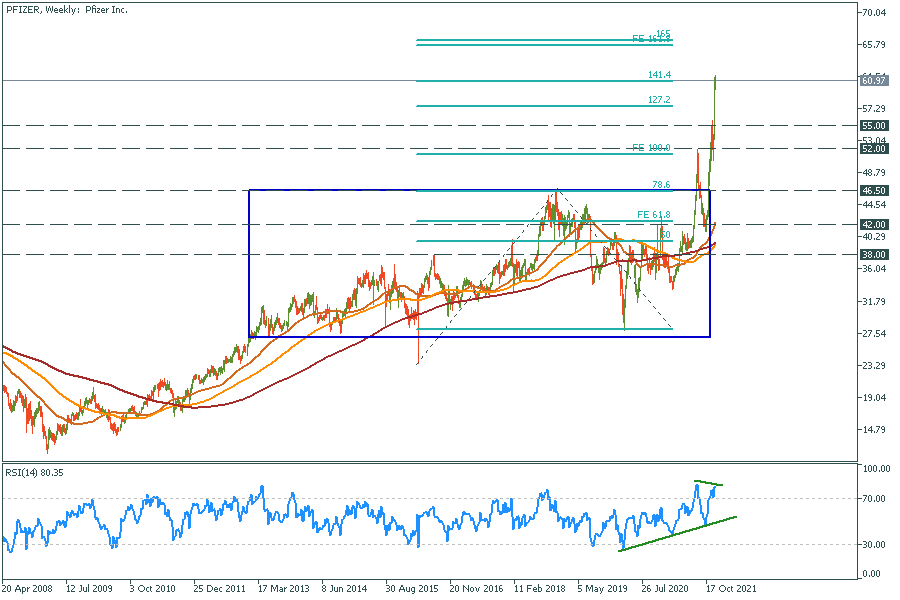
After a pullback because of divergence on both weekly and daily RSI, we expect Pfizer to reach $66 for a stock, with prospects to reach $75 by the end of 2022. However, we cannot predict random news, so be careful and watch for reactions to $46.5 and $42 levels.
Resistance: 66.0; 75.0
Support: 55.0; 52.0; 46.5; 42.0; 38.0


The S&P 500 had a good week due to the impressive start of Q1 earnings and favorable inflation data. In March, the consumer price index rose 5%, lower than the previous month's 6%, and met economists' expectations.

FAANG stocks started recovering. Which ones are the best according to fundamental analysis?

The previous year 2022, was undoubtedly tumultuous for the stock markets, with several stocks plummeting across multiple industries. Analysts have blamed the hard times on inflation, hawkish federal reserve policies, an impending global recession, and the ongoing crisis in Ukraine. This year, however, we're beginning to see some recovery in the stock markets. This article will find a few stocks worth buying this year.

eurusd-is-falling-what-to-expect-from-the-future-price-movement

Greetings, fellow forex traders! Exciting news for those with an eye on the Australian market - the upcoming interest rate decision could be good news for Aussies looking to refinance or take out new loans. The Mortgage and Finance Association Australia CEO, Anja Pannek, has...

Hold onto your hats, folks! The Japanese yen took a nosedive after the Bank of Japan (BOJ) left its ultra-loose policy settings unchanged, including its closely watched yield curve control (YCC) policy. But wait, there's more! The BOJ also removed its forward guidance, which had previously pledged to keep interest rates at current or lower levels. So, what's the scoop? Market expectations had been subdued going into the meeting, but some were still hoping for tweaks to the forward guidance to prepare for an eventual exit from the bank's massive stimulus
Your request is accepted.
We will call you at the time interval that you chose
Next callback request for this phone number will be available in 00:30:00
If you have an urgent issue please contact us via
Live chat
Internal error. Please try again later